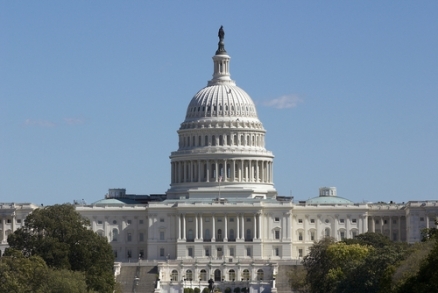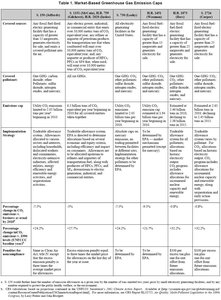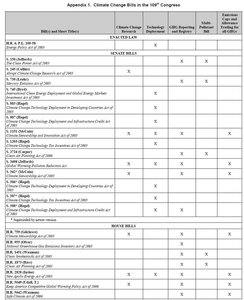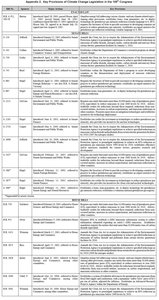109th Congress
Contents
- 1 Climate change legislation in the 109th United States Congress
- 1.1 Introduction Climate change (Climate change legislation in the 109th United States Congress) is viewed as a global issue, but proposed responses generally require action at the national level. In 1992, the United States ratified the United Nations’ Framework Convention on Climate Change (UNFCCC), which called on industrialized countries to take the lead in making voluntary efforts to reduce greenhouse gases (Note 1). Over the past decade, a variety of voluntary and regulatory actions have been proposed or undertaken in the United States, including monitoring of utility carbon dioxide emissions, improved appliance efficiency, and incentives for developing renewable energy sources. In 2001, President George W. Bush rejected the Kyoto Protocol to the UNFCCC, which called for legally binding commitments by developed countries to reduce their greenhouse gas emissions. Instead, the Bush Administration has focused on reducing the greenhouse gas intensity (Note 2) of the U.S. economy. In the meantime, some states and local governments, as well as private entities, have taken actions to reduce emissions and limit the potential impacts of climate change. In light of these actions, a number of bills have been introduced in Congress to address climate change.
- 1.2 Energy bill ammendments
- 1.3 Climate change research bills
- 1.4 Deployment of greenhouse gas reduction technology
- 1.5 GHG reporting and registry bills
- 1.6 GHG emission-reduction bills
- 1.7 Appendices
Climate change legislation in the 109th United States Congress
Introduction Climate change (Climate change legislation in the 109th United States Congress) is viewed as a global issue, but proposed responses generally require action at the national level. In 1992, the United States ratified the United Nations’ Framework Convention on Climate Change (UNFCCC), which called on industrialized countries to take the lead in making voluntary efforts to reduce greenhouse gases (Note 1). Over the past decade, a variety of voluntary and regulatory actions have been proposed or undertaken in the United States, including monitoring of utility carbon dioxide emissions, improved appliance efficiency, and incentives for developing renewable energy sources. In 2001, President George W. Bush rejected the Kyoto Protocol to the UNFCCC, which called for legally binding commitments by developed countries to reduce their greenhouse gas emissions. Instead, the Bush Administration has focused on reducing the greenhouse gas intensity (Note 2) of the U.S. economy. In the meantime, some states and local governments, as well as private entities, have taken actions to reduce emissions and limit the potential impacts of climate change. In light of these actions, a number of bills have been introduced in Congress to address climate change.
In the 109th Congress, numerous bills have been introduced that directly or indirectly address climate change. Several bills address the climate change issue directly, either through emissions limits, incentives for reductions, or research and information gathering on climate change and greenhouse gas emissions mitigation. This report describes and compares bills that directly address climate change, as opposed to those that address other issues but could have ancillary impacts (e.g., energy efficiency and conservation). Topics covered by these bills fall into four major categories: (1) those that would promote research on the effects of climate change and on methods to measure and predict climate change; (2) those that would create incentives for the deployment of emission-reducing technologies in the United States or other countries; (3) those that would establish greenhouse gas (GHG) monitoring systems as a basis for research or for any potential reduction program; and (4) those that would establish market-based programs to directly limit greenhouse gas emissions. These categories are not mutually exclusive, and several bills address more than one of the above categories. The major provisions of these bills are categorized in Appendix 1 and summarized in Appendix 2.
In several cases, bill sponsors have introduced modified versions of their climate change bills. For the purposes of the discussion below, it is assumed that the newest version supersedes earlier versions. These bills include S. 1151 for S. 342 (McCain); S. 883 for S. 386 (Hagel); S. 887 for S. 388 (Hagel); and S. 1203 for S. 387 (Hagel).
Energy bill ammendments
On August 8, 2005, President Bush signed the Energy Policy Act of 2005 (P.L. 109-58, H.R. 6). Title XVI establishes a voluntary national program designed to accelerate demonstration and deployment of less-carbon-intensive technology to encourage voluntary reductions in greenhouse gases. The title attempts to support actions focused on reducing U.S. carbon intensity (the ratio of greenhouse gas emissions per unit of gross domestic product). The program would not establish a requirement to reduce emissions. This title also establishes a program to encourage exports of carbon intensity-reducing technologies to developing countries.
As part of the Senate debate over H.R. 6, several amendments on climate change were offered. S.Amdt. 817, which inserted a new Title XVI in the bill, incorporates language from S. 883 and S. 887. This amendment was agreed to on a 66-29 vote. These provisions are similar to those included in the final version of the bill. The House version of H.R. 6 did not expressly address climate change issues.
Not included in the final bill was Section 1612 of the Senate bill, which expressed the Sense of the Senate that human activities are a substantial cause of greenhouse gas accumulation in the atmosphere, causing average temperatures to rise. Further, the resolution stated that “Congress should enact a comprehensive and effective national program of mandatory market-based limits and incentives on emissions of greenhouse gases that slow, stop, and reverse the growth of such emissions at a rate and in a manner that : (1) will not significantly harm the United States economy; and (2) will encourage comparable action by other nations that are major trading partners and key contributors to global emissions.” This was the first Sense of the Senate resolution on climate change since S.Res. 98 in 1997, which voiced concern over the economic effects of emissions limits and the sense that developing countries must participate in meaningful action to control emissions. S.J.Res. 5 similarly urges U.S. action on climate change. This resolution has been referred to committee.
The Senate also debated whether to adopt S.Amdt. 826, which contained language similar to S. 1151. This amendment would have established a mandatory cap-and-trade system to limit greenhouse gas emissions from covered entities to year 2000 levels by 2010. This amendment was rejected on a 38-60 vote.
Climate change research bills
Global climate change is a complex issue. While most scientists agree that the climate is changing in response to greenhouse gas (GHG) emissions, uncertainties concerning the causes and the effects of climate change remain and are a continuing subject of extensive scientific research (Note 3). Further, research is ongoing into technologies to improve efficiency, reduce fossil fuel consumption, and sequester carbon dioxide emissions.
Research Bills. One bill in the 109th Congress, S. 245 (Collins), focuses solely on climate change research.4 S. 245 calls for the development and testing of climate change models based on historic climatic changes, and to incorporate nonlinear aspects of geophysical systems that could lead to abrupt changes in climate.
Research Provisions in Broader Bills. In addition to S. 245, several bills include climate change research provisions as part of a broader climate change legislation. Specifically, research in S. 1151, S. 3698, H.R. 759, and H.R. 2828 would focus on abrupt climate change research and new climate change measurement technologies. H.R. 5049 would establish a new Advanced Research Projects Agency within the Department of Energy.
Deployment of greenhouse gas reduction technology
In the 109th Congress, several bills would promote the deployment and diffusion of technologies to reduce greenhouse gas emissions, either as part of broader legislation to limit greenhouse gases, or as stand-alone legislation. Deployment strategies include tax incentives for investment in technologies to improve efficiency and/or lower emissions and grants, loans, and other incentives for technology transfer to developing countries. S. 1203 (Hagel) would establish tax incentives for investment in technologies to reduce greenhouse gas intensity. S. 745 (Byrd), S. 883 (Hagel), S. 1151 (McCain), and S. 3698 (Jeffords) would establish grant and loan programs to deploy technologies in developing countries that have been developed or demonstrated in the United States. S. 887 (Hagel) would establish a credit-based deployment program for technologies to reduce greenhouse gas intensity; support would include direct loans, loan guarantees, lines of credit, and production incentive payments. The final version of H.R. 6 incorporates language similar to S. 883 and S. 887. H.R. 2828 (Inslee) provides a wide array of incentives for improvements in energy efficiency and other strategies that would reduce greenhouse gas emissions.
In addition to the above bills on technology deployment, §585(b) of the fiscal year (FY) 2006 Foreign Operations Appropriation Act (P.L. 109-102) requires the President to submit (within 60 days of submitting the FY2007 budget request) a report on federal agency expenditures (foreign and domestic) on climate change activities. The act specifically requires a report on U.S. Agency for International Development funding for climate change activities in developing countries, including technology deployment.
GHG reporting and registry bills
Under the UNFCCC, the United States annually publishes reports on its GHG emissions (Note 5). The United States Environmental Protection Agency (EPA) does this reporting using various techniques (e.g., fuel analysis for CO2). The three dominant sources of GHG emissions are electricity generation (33.1%), transportation (26.9%), and industry (19%) (Note 6). At the national level, electric utilities must report their GHG emissions pursuant to the 1990 Clean Air Act, but there is no overall national GHG reporting requirement. However, some states also gather data through voluntary or mandatory GHG emissions reporting mechanisms (Note 7).
H.R. 955 (Olver) focuses primarily on expanding emissions reporting to include a broad array of sources. All entities that emit more than 10,000 metric tons of carbon dioxide equivalent must report their emissions, except that farms are exempt. Further, manufacturers and importers of automobiles and Department of Energy listed products (Note 8) must report the emissions from their products. The purpose of the bill is to promote greenhouse gas reductions and to generate accurate emissions data that can be used by public and private entities for various purposes. In addition to H.R. 955, which focuses solely on GHG reporting, several other bills would require emissions monitoring and reporting as part of a program to reduce emissions of carbon dioxide or of all greenhouse gases. These emissions reductions efforts are discussed in the following section. S. 150 (Jeffords), S. 730 (Leahy), H.R. 1451 (Waxman), and H.R. 1873 (Bass) would require electricity producers to report their carbon dioxide emissions in order to determine compliance with carbon dioxide caps. S. 1151 (McCain), H.R. 759 (Gilchrest), and H.R. 2828 (Inslee) would require major emitters of all six greenhouse gases to report their emissions; the bills require reporting from entities that emit more than 10,000 metric tons (11,000 tons) of carbon dioxide equivalent. H.R. 5049 (Udall, T.) would require all fossil fuel suppliers to report the amount of greenhouse gases that will result from combustion of the fuel supplied.
GHG emission-reduction bills
The United States has no federal GHG reduction requirements, though there are proposals to require such reductions. These proposals include “command and control” regulations on emissions, GHG emission taxes, and market-based techniques to limit emissions. The latter, market-based programs typically take as their model the Clean Air Act’s acid rain program (Note 9).
In the 109th Congress, bills have been introduced that would establish market-based caps on GHG emissions. These bills are compared in Table 1. Three bills, S. 1151 (McCain), H.R. 759 (Gilchrest), and H.R. 2828 (Inslee), would cap the emissions of the six greenhouse gases specified in the United Nations’ Framework Convention on Climate Change. Five other bills, S. 150 (Jeffords), S. 730 (Leahy), S. 2724 (Carper), H.R. 1451 (Waxman), and H.R. 1873 (Bass), would focus on reducing carbon dioxide from electric utilities. Each of these bills would use market-based trading mechanisms to limit GHG emissions. Cap-and-trade programs set strict limits on specific emissions from a particular group of sources, allowing individual sources to trade reductions. This flexibility in who makes reductions can lead to lower costs. In an efficient market, entities that face relatively low emission reduction costs could achieve extra emission reductions. These entities could then sell their unused allowances to entities that face higher emission-reduction costs. An entity facing higher costs could purchase allowances that would allow it to emit more than its initial emissions allotment would otherwise permit. It should be noted that in all cases, total U.S. emissions may decrease or increase depending on the entities covered, the greenhouse gases controlled, and the emissions trading schemes.
Another market-based option is to require tradeable emissions permits, but establish a “safety valve” price. In this scenario, if the market value of a permit exceeds a set price — the safety valve — covered entities can purchase an unlimited number of permits from the government. In this way, the overall price to covered entities — and the economy — is limited, but specific emission reduction targets may not be reached. H.R. 5049 (Udall, T.) would establish a such a system.
Carbon Dioxide Reduction Bills
As shown in Table 1, S. 150, S. 730, H.R. 1451, and H.R. 1873 focus on electric utility emissions. These “multipollutant” bills would limit emissions of carbon dioxide, along with other air pollutants (Note 10). (See Table 1.) In all four cases, carbon dioxide emissions limitations would start in 2010 (Note 11).
Comprehensive GHG Emissions Reductions
Unlike other bills proposed in the 109th Congress, the Climate Stewardship Act of 2005 (H.R. 759), the New Apollo Energy Act of 2005 (H.R. 2828), and the Climate Stewardship and Innovation Act of 2005 (S. 1151) focus on achieving market-driven reductions in all six greenhouse gases (see Table 1). The legislation applies to entities in the electricity, transportation, industry, and commercial sectors that emit over 10,000 metric tons (11,000 tons) of greenhouse gases per year. Starting in 2010, the bills would cap total GHG emissions from all these sources at 6.5 billion tons (CO2 equivalent emissions), reduced by the amount of CO2 (equivalent emissions) from non-covered entities in the year 2000. The bills would also establish a formula for allocating GHG emissions allowances, and a climate change credit corporation to manage allowance trading. Language similar to S. 1151 was offered as an amendment on the Senate floor to H.R. 6. This amendment was rejected on a 38-60 vote.
In addition to establishing caps on all six greenhouse gases, the above bills would support climate change research and establish a GHG emissions inventory (see above). The bills also include a requirement that the Administrator of the EPA establish a national GHG database, and develop methods and standards to measure and verify GHG emissions.
The Safe Climate Act of 2006 (H.R. 5642) and the Global Warming Pollution Act (S. 3698) would grant EPA broad authority to establish regulations such that total greenhouse gas emissions are reduced to 80% below 1990 levels by 2050. These bills do not designate covered entities or required reduction levels for specific sectors, but leave those decisions to EPA’s discretion.
Safety Valve Bills
The Keep America Competitive Global Warming Policy Act of 2006 (H.R. 5049) would establish a system of allowances for fossil fuel suppliers and a safety valve of $25 per ton of carbon, indexed to inflation.



